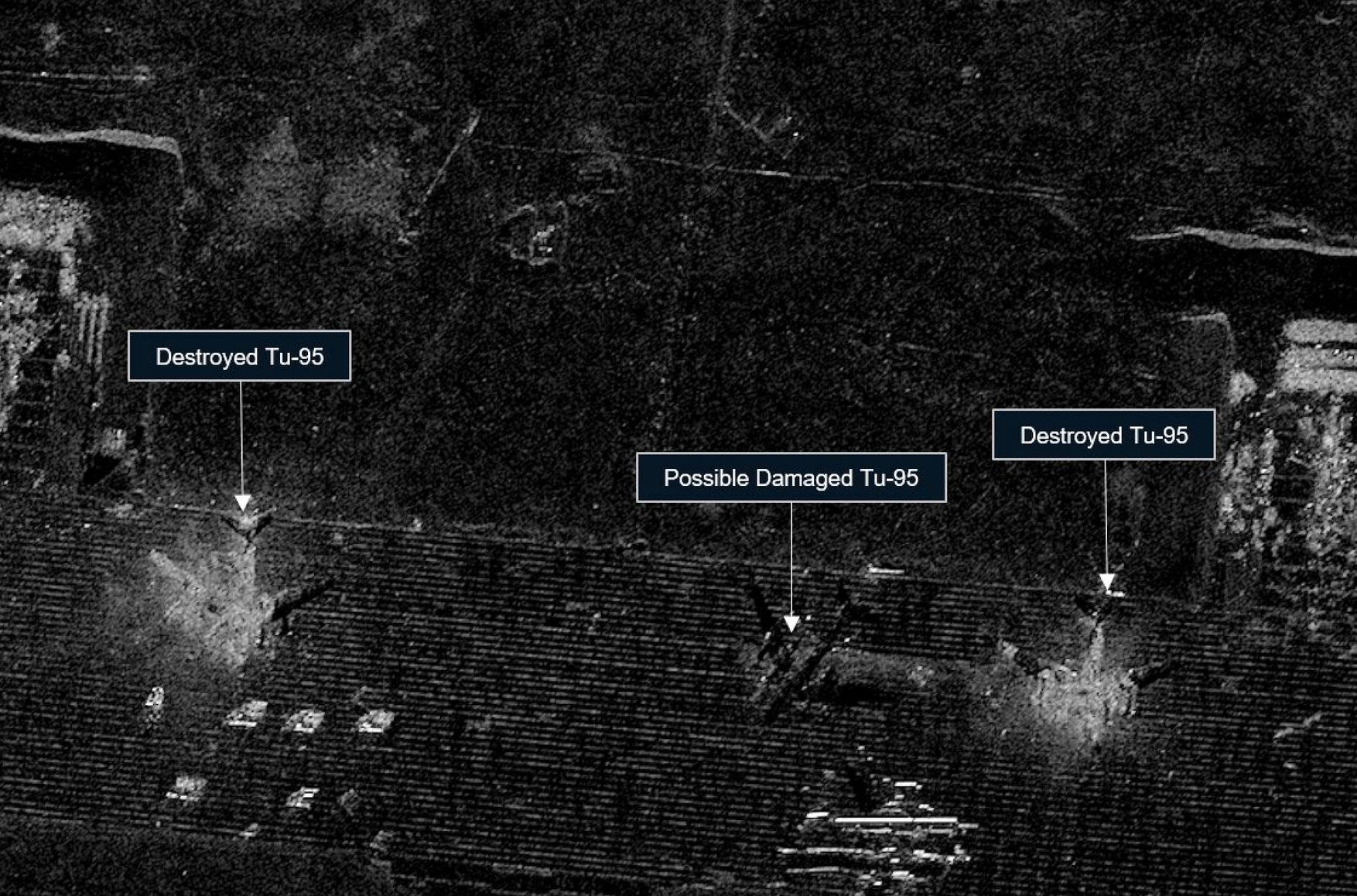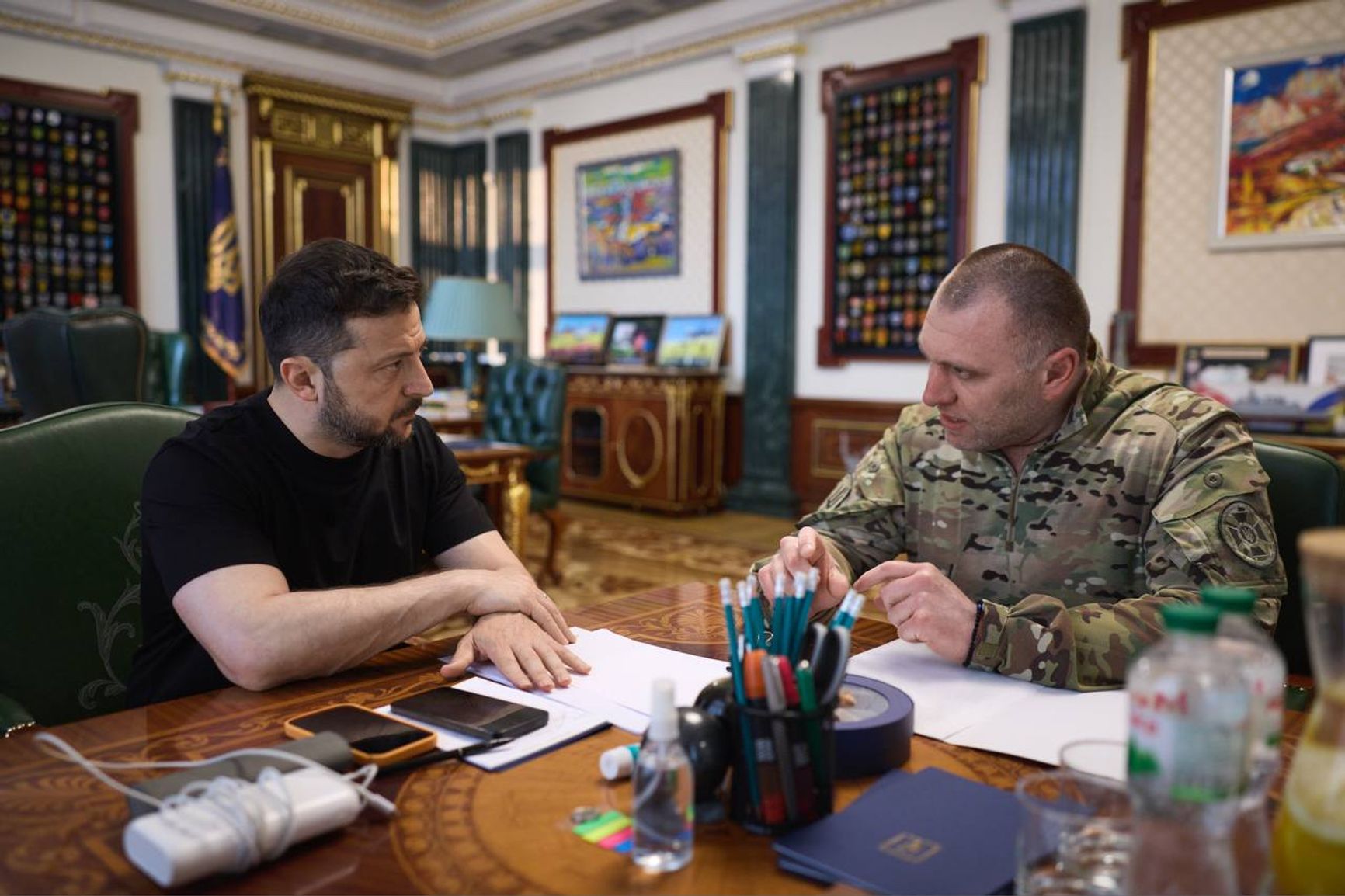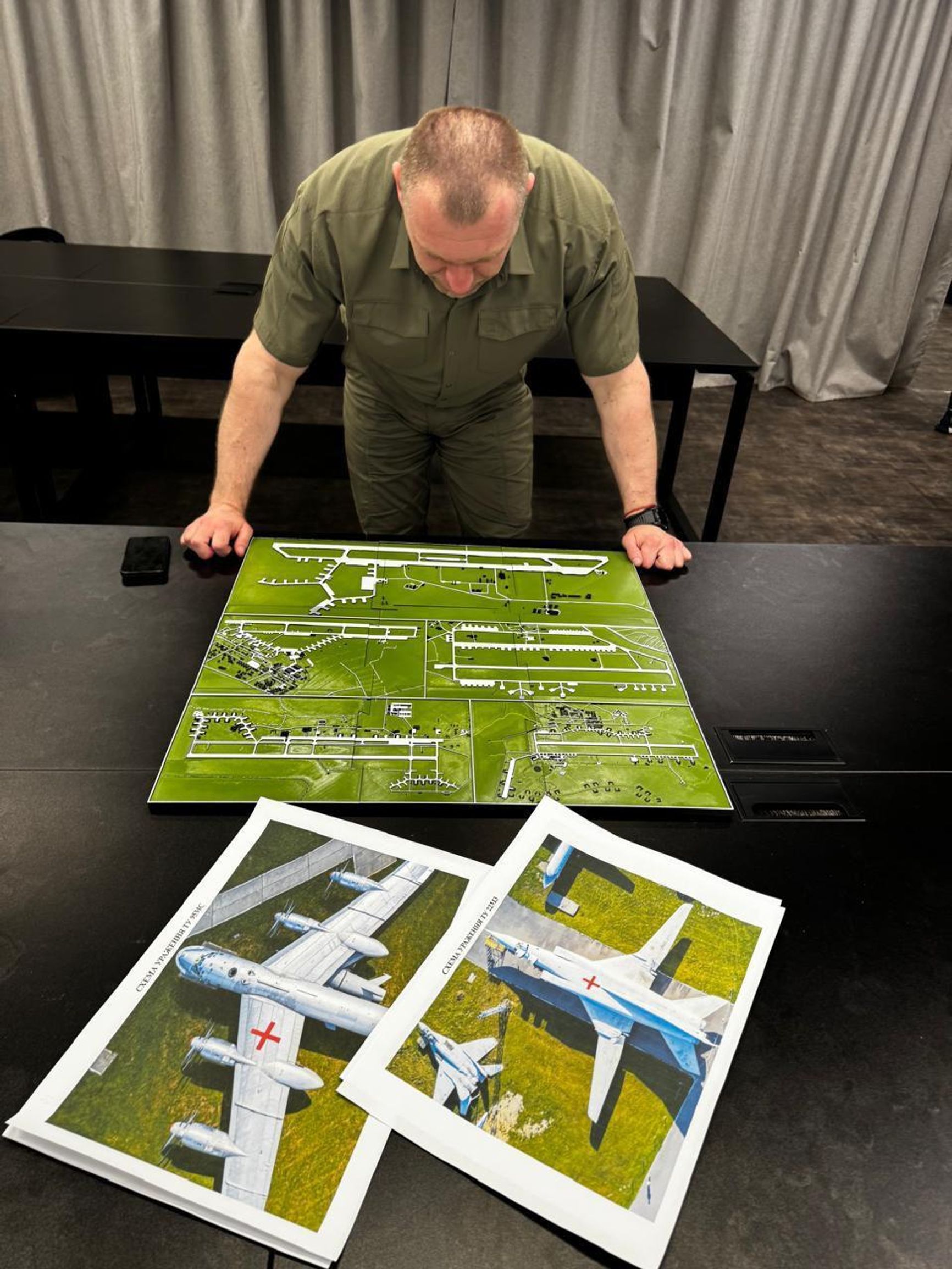
Screenshot of satellite images confirming Ukrainian strikes on Russia's Belaya long-range aviation air base with FPVs. Image: Chris Biggers (X: @CSBiggers)
Satellite imagery and video confirmations from open-source intelligence (OSINT) analysts have verified that at least 13 Russian strategic aircraft were damaged during Operation Spiderweb (“Pavutyna”), carried out by the Security Service of Ukraine (SBU) on June 1.
Geospatial analyst Chris Biggers published satellite images captured by Umbra Space showing the aftermath at Belaya air base in Russia’s Irkutsk Region — thousands of kilometers away from the Russia-Ukraine border. The images confirm strikes on four Tu-95 strategic bombers and four Tu-22M3 bombers.
Satellite image of Belaya air base in Russia’s Irkutsk Region
Source: Chris Biggers
Satellite image of Belaya air base in Russia’s Irkutsk Region
Source: Chris Biggers
Separately, Ukrainian outlet Oko Hora ✙ News and Analysis confirmed, through video footage, the damage to five additional aircraft at the Olenya air base in Russia’s northern Murmansk Region — four Tu-95s bombers and one An-12 transport aircraft.
As of the morning of June 2, the confirmed tally of damaged Russian strategic aircraft stands at:
- Eight Tu-95 bombers
- Four Tu-22M3 bombers
- One An-12 transport aircraft
Operation Spiderweb was the largest strike on Russian airbases since the start of the full-scale invasion and had been in planning for over 18 months, reportedly overseen personally by President Volodymyr Zelensky. It specifically targeted Russia’s strategic aviation fleet, responsible for launching missile strikes on Ukrainian cities.
SBU chief Vasyl Malyuk reported that 41 aircraft were hit — including the A-50, Tu-95, Tu-22 M3, and Tu-160 — adding that “34% of [Russia’s] strategic cruise missile carriers” had been destroyed in the operation. The SBU also claimed the destroyed Russian equipment was worth approximately $7 billion, though this figure could not be independently verified.
According to Zelensky, a total of 117 drones — and a corresponding number of operators — were used in the operation.
“These are Ukrainian deeds that will undoubtedly be in history books,” Zelensky wrote in a prior post.

SBU head Vasyl Malyuk reports the results of Operation Spiderweb to Ukrainian President Volodymyr Zelensky.
Photo: Zelenskiy / Official (Telegram)
The attacks targeted five Russian strategic aviation bases, although confirmed damage has so far only been verified at two: Belaya and Olenya.
Aside from the bases in Murmansk and Irkutsk, Ukrainian and Russian media reported strikes on Dyagilevo air base in the Ryazan Region, Ivanovo Severny airfield in the Ivanovo Region, and Ukrainka air base in the Amur Region. A photo released by SBU head Vasyl Malyuk suggests those sites were also targets, although no successful strikes have yet been confirmed. Russia’s Ministry of Defense (MoD) claims those attacks were repelled.

SBU head Vasyl Malyuk looks at maps of the Russian air bases targeted in Operation Spiderweb.
Photo: SBUkr (Telegram)
Regional authorities confirmed the strikes. Murmansk Governor Andrey Chibis said air defenses, law enforcement, and emergency services were “carrying out the necessary operations” and urged locals not to post photo or video footage of the area online. Irkutsk Governor Igor Kobzev said that drones had attacked a military unit in the settlement of Sredny, roughly five kilometers from Belaya air base.
Russia’s MoD confirmed the drone attacks on Belaya and Olenya, with “several aircraft catching fire.” Attacks in three other regions were reportedly repelled. The military said no casualties occurred and that several individuals had been detained.
The drones were smuggled into Russia and launched remotely from the back of trucks.
“Our personnel operated across multiple Russian regions – in three different time zones. And the people who assisted us were withdrawn from Russian territory before the operation, they are now safe,” wrote President Zelensky.
Videos circulating online appear to show drones emerging from a truck parked on the side of a road near Olenegorsk in the Murmansk Region. The Telegram channel Baza — widely considered to be linked to the Russian authorities — reported that the truck’s driver was detained, although he may have been unaware his vehicle was used to launch drones. “The truck was parked near Olenegorsk. The driver was running around as drones launched toward Vysoky. Traffic police have taken him in,” a source told the channel.
Similar footage, pictured above, was captured in Irkutsk.
The pro-war Telegram channel Zergulio published images purportedly showing the warehouse where the drone containers were assembled. The photos show a logo from Chelyabinsk-based real estate agency DAN-Nedvizhimost. The location resembles that shown in drone-related imagery shared by Ukrainian sources. The channel linked to a real estate listing indicating the warehouse, at 28A Sverdlovsky Trakt in Chelyabinsk, was leased for 350,000 rubles per month.
Russian pro-war channels identified the building — a warehouse in Chelyabinsk — where the drones were reportedly assembled.
Photo: DAN Nedvizhimost
Drones used by the SBU to attack Russian military airfields.
Photo: Suspilne (source in the SBU)
Drones used by the SBU to attack Russian military airfields.
Photo: Suspilne (source in the SBU)
Drones used by the SBU to attack Russian military airfields.
Photo: Suspilne (source in the SBU)
The owners of the building have been arrested, according to reports by the outlets Baza and Mash. A report by the pro-Kremlin regional outlet Ura.ru indicated that its tenants are also under arrest. “The warehouses are currently empty. Samples have been taken to check for the possible presence of explosives inside the premises,” the publication wrote.
Some pro-war channels speculated about the routes that the trucks — and drones — may have used to enter Russia. “It is worth noting that the Chelyabinsk Region borders Kazakhstan, from where FPV drones could have reached Russia,” wrote the pro-war channel War with Fakes.
The strikes appear to have directly targeted the air-based leg of Russia’s nuclear triad. According to a decree signed by President Vladimir Putin, an attack on critical military infrastructure that disrupts Russia’s ability to mount a nuclear response could trigger the use of nuclear weapons. However, independent analyst Pavel Podvig, an expert on Russia's nuclear forces, told The Insider that such a scenario remains unlikely:
“I still believe — and hope — there is no cause for that. The wording [of the decree] is intentionally vague, as designed. But strictly speaking, even a serious attack like this is unlikely to cripple the nuclear response capability. That’s one factor. Another is: use nuclear weapons for what purpose? There’s no realistic scenario. I think Russia will find a way to respond — but it won’t involve nuclear weapons.”
Reactions
Russian pro-war bloggers — also known as “Z-bloggers” due to their support for a war often symbolised by the letter Z — widely agreed that Ukraine is “moving the red lines” and described the attack as a major failure of Russian military command.
“This is Russia’s Pearl Harbor,” wrote commentator Roman Alekhin, expressing hope that the response will be “just as harsh as America’s — or even stronger.” The Insider’s Timur Olevsky drew a different comparison: “This isn’t Pearl Harbor. It’s Operation Frantic.”
The pro-war channel Voevoda Veshchaet (lit.”Warlord Speaks”) called for the execution of 500 Ukrainian prisoners of war “on camera” as retaliation for the attacks, demanding such actions continue until Ukraine stops. The channel made no mention of Russian prisoners held by Ukraine.
“I can’t even imagine how to respond to this — or with what,” the blogger wrote. “And no, we don’t have dozens of countries ready to send us aircraft. What does the Chief of the General Staff think — same as he did about Kursk in the early days of the invasion?”
The pro-Russian Notes of Midshipman Ptichkin said the drone strikes on strategic airbases nearly 2,000 kilometers from the Ukrainian border “warranted declaring a real war.”
“This is a complete failure of the structures responsible for the security of [Russia’s] strategic aviation airfields,” echoed Z-blogger Boris Rozhin. Self-styled “war correspondent” Alexei Zhirov lashed out at Murmansk Governor Andrey Chibis for claiming that Russian air defenses were “working” at the time of the strikes. “What was the air defense responding to — tactical FPV drones? Why make a statement like that at all?” Zhirov asked.
Andrey Filatov, a correspondent at the state-controlled channel RT, blamed corruption: “The army’s brain is senile. The middle ranks are knee-deep in grift and asset grabs. The counter-drone tech exists, but it won’t be procured until someone buys it cheap or hijacks the contract. Even basic FPV countermeasures are beyond these aging generals. The coming PR response will be dumber still.”
The aviation-focused Z-channel Fighterbomber noted that neither tire stacks around the aircraft nor fake plane silhouettes painted on runways helped repel the attack: “Today will later be remembered as a black day for Russia’s long-range aviation.”